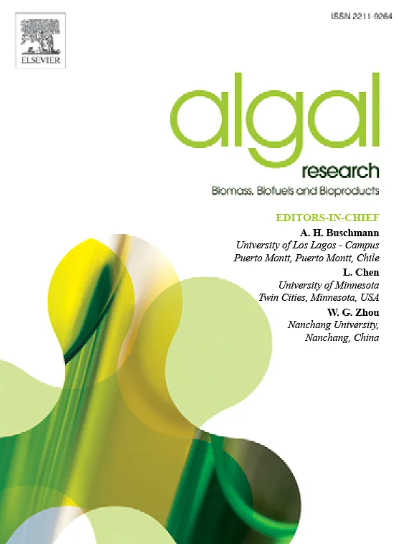Screening enzymatic extracts of Palmaria palmata based on composition and bioactivity
IF 4.6
2区 生物学
Q1 BIOTECHNOLOGY & APPLIED MICROBIOLOGY
Algal Research-Biomass Biofuels and Bioproducts
Pub Date : 2025-04-21
DOI:10.1016/j.algal.2025.104048
引用次数: 0
Abstract
This study evaluated enzymatic extracts of Palmaria palmata for protein, amino acid, and phenolic contents, as well as their bioactivity including in-vitro antioxidant (radical scavenging and metal ion chelation), antidiabetic (α-glucosidase inhibition), and anti-obesity (porcine pancreatic lipase inhibition) properties. Three proteases including Alcalase®, Flavourzyme®, and Formea® Prime (trypsin) were applied at concentrations of 1 %, 2 %, and 3 % of protein content in biomass (% dry weight). The proteases were also investigated combined with a polysaccharidase (Celluclast®), either simultaneously or sequentially. The highest protein content and recovery were achieved when Alcalase® and Flavourzyme® were applied together (17.29 ± 0.17 % and 54.64 ± 1.53 %, respectively). Alcalase® generally produced extracts with higher protein, essential amino acids, and phenolic contents. Formea® Prime contributed to higher radical scavenging activities, with the Alcalase® and Formea® Prime combination showing the best radical scavenging (IC50 = 1.04 ± 0.32 mg mL−1). However, the extracts exhibited limited metal chelation activity. The best α-glucosidase inhibition was observed with Formea® Prime (35.51 ± 2.98 %) and Alcalase® (26.16 ± 2.85 %) alone at 16 mg mL−1. Extracts with higher arginine content generally showed greater lipase inhibition, with the highest inhibition seen in the Alcalase® and Flavourzyme® combination (44.23 ± 0.39 %). However, this extract was low in arginine concentration, suggesting the effect might be due to peptide-polyphenol interactions. Addition of Celluclast® did not enhance the properties of the extracts and, in some cases, reduced them. Principal component analysis (PCA) indicated that radical scavenging and anti-obesity properties are likely governed by protein and phenolic contents and specific amino acids.

基于成分和生物活性筛选掌叶芭蕉酶提取物
本研究评估了棕榈叶酶提取物的蛋白质、氨基酸和酚类含量,以及它们的生物活性,包括体外抗氧化(自由基清除和金属离子螯合)、抗糖尿病(α-葡萄糖苷酶抑制)和抗肥胖(猪胰脂肪酶抑制)的特性。三种蛋白酶分别为Alcalase®、Flavourzyme®和Formea®Prime(胰蛋白酶),浓度分别为生物质蛋白质含量(%干重)的1%、2%和3%。同时或依次将蛋白酶与多糖酶(Celluclast®)结合进行研究。Alcalase®和Flavourzyme®同时使用时,蛋白质含量和回收率最高(分别为17.29±0.17%和54.64±1.53%)。Alcalase®通常生产的提取物具有较高的蛋白质,必需氨基酸和酚含量。Formea®Prime具有较高的自由基清除活性,其中Alcalase®和Formea®Prime组合具有最佳的自由基清除能力(IC50 = 1.04±0.32 mg mL−1)。然而,提取物表现出有限的金属螯合活性。在16 mg mL−1浓度下,Formea®Prime(35.51±2.98%)和Alcalase®(26.16±2.85%)对α-葡萄糖苷酶的抑制效果最好。精氨酸含量越高的提取物对脂肪酶的抑制作用越强,Alcalase®和Flavourzyme®组合的抑制作用最高(44.23±0.39%)。然而,这种提取物的精氨酸浓度很低,表明这种效果可能是由于多肽-多酚相互作用。添加Celluclast®并没有增强提取物的性能,在某些情况下,还降低了它们的性能。主成分分析(PCA)表明,自由基清除和抗肥胖特性可能与蛋白质和酚类含量以及特定氨基酸有关。
本文章由计算机程序翻译,如有差异,请以英文原文为准。
求助全文
约1分钟内获得全文
求助全文
来源期刊

Algal Research-Biomass Biofuels and Bioproducts
BIOTECHNOLOGY & APPLIED MICROBIOLOGY-
CiteScore
9.40
自引率
7.80%
发文量
332
期刊介绍:
Algal Research is an international phycology journal covering all areas of emerging technologies in algae biology, biomass production, cultivation, harvesting, extraction, bioproducts, biorefinery, engineering, and econometrics. Algae is defined to include cyanobacteria, microalgae, and protists and symbionts of interest in biotechnology. The journal publishes original research and reviews for the following scope: algal biology, including but not exclusive to: phylogeny, biodiversity, molecular traits, metabolic regulation, and genetic engineering, algal cultivation, e.g. phototrophic systems, heterotrophic systems, and mixotrophic systems, algal harvesting and extraction systems, biotechnology to convert algal biomass and components into biofuels and bioproducts, e.g., nutraceuticals, pharmaceuticals, animal feed, plastics, etc. algal products and their economic assessment
 求助内容:
求助内容: 应助结果提醒方式:
应助结果提醒方式:


